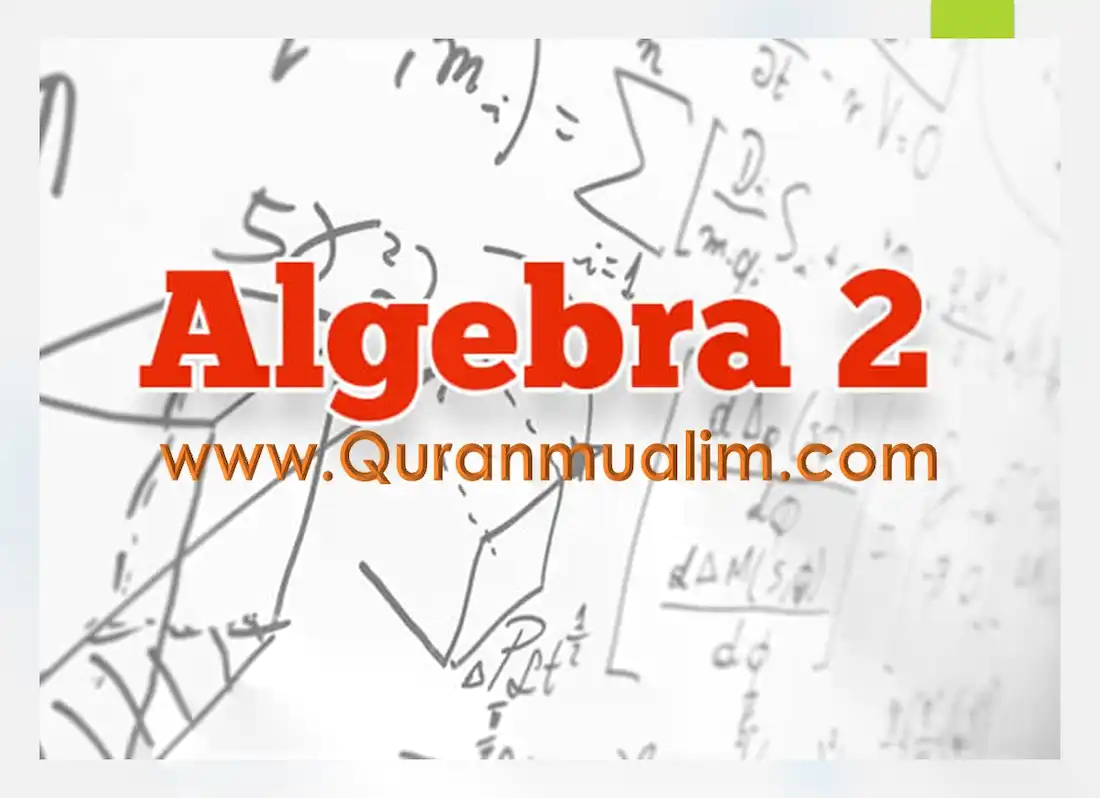Algebra 2 Formula Sheet Free Download . Graphs of Linear Equations reviews the rectangular (Cartesian) coordinate system, and contains lessons on different methods of interpreting the lines and their applications, and has examples of solving different practice problems related to finding the slope and using different forms of writing the equation for a line. Topics include:
Finding the Slope of a Line from a Graph
Finding the Slope of a Line from an Equation
Applications of Linear Equations
Rectangular Coordinate System
Midpoint Formula
Slope
Slope-Intercept Form of a Line
Point-Slope Form of a Line
Standard Form of a Line
Functions
Functions teaches students how to properly use function notation and how to answer questions related to them, such as how to find domain and range, how to define a function, and how to interpret word problems with direct and indirect variation. Topics include:
• Introduction to Functions
• Domain and Range
• Function Notation
• Direct Variation
• Indirect Variation
• Joint and Combined Variation
• Composition of Functions
Systems of Linear Equations
Systems of Linear Equations teaches students different ways of dealing with problems relating to systems of equations in two or more variables and how to recognize systems with no or infinite solutions both algebraically and with graphs. Students can practice with word problems that apply systems of equations and learn different methods for solving systems including elimination and substitution. Topics include:
Solving a System of Linear Equations in Two Variables
Solving a Linear System in Three Variables with a Solution
Solving a Linear System in Three Variables with no or Infinite Solutions
Matrices
Matrices helps students learn how to properly use matrix operations such as switching and adding scalar multiples of rows , and gives practice with the applications of an augmented matrix. Topics include:
• Introduction to Matrices
• Matrix Operations
•Augmented Matrices
•Matrix Multiplication
Polynomials
Polynomials teaches students how to define a polynomial function and provides practice on how to interpret the graphs of basic polynomials and their transformations, and how to multiply and divide them both with long and synthetic division. Topics include:
• Introduction to Polynomials
• Polynomial Function
• Basi Polynomial Graphs
• Basic Transformations
•Multiplying Polynomials
• Multiplying Complicated Polynomials
•Pascal’s Triangle
• Binomial Theorem
• Dividing Polynomials using Long Division
•Dividing Polynomials using Synthetic Division
• Using Synthetic Division to Evaluate Polynomials
Factoring – Algebra 2 Formula Sheet
Factoring reviews methods to factor real and imaginary terms out of polynomials, including quadratics, cubics and those of higher degree. Students can learn how to use the rational roots theorem and synthetic division through lectures and practice problems similar to those that would appear on their homework. Topics include:
- Review of the Methods of Factoring
- Factoring Complicated Expressions
- Factoring the Sum or Difference of Cubes
- Using Synthetic Division to Factor
- Solving by Factoring
- Rational Roots Theorem
- Using Synthetic Division to Solve an Equation
Rational Expressions and Functions
Rational Expressions and Functions defines rational expressions and discusses their domains and asymptotic behavior as functions. Students can learn and practice methods of simplifying, solving and graphing rational functions through various exercises they would find in their homework, including word problems dealing with distance, rate and time and those dealing with work. Topics include:
- Definition and Domain of a Rational Expression
- Multiplying and Dividing Rational Expressions
- Adding and Subtracting Rational Expressions
- Simplifying Complex Fractions
- Solving a Rational Equation
- Graphing a Rational Expression
- Solving a Rational Equation for a parameter
Roots and Radicals
Roots and Radicals introduces students to rational exponents and helps with studying how to simplify and otherwise manipulate expressions with radicals and roots using their properties and rules. Students will learn through practice problems like those found in their homework how to rationalize, combine, expand radicals. Topics include:
- Introduction to Radicals
- Radicals and Absolute Values
- Rational Exponents
- Evaluating Rational Exponents
- Rational Exponents with Negative Coefficients
- Rules for Rational Exponents
- Multiplying Radicals of the Same Root
- Multiplying Radicals of Different Roots
- Rationalizing the Denominator with Higher Roots
- Rationalizing a Denominator with a Binomial
- Solving an Equation with Radicals
- Introduction to Imaginary Numbers
- Adding and Subtracting Complex Numbers
- Multiplying Complex Numbers
- Dividing Complex Numbers
- Powers of i
Quadratic Equations and Inequalities
Quadratic Equations and Inequalities introduces students to the graphs of quadratics, teaches them to find the vertex, intercepts, discriminant, domain and range and interpret the graph in relation to these qualities. It also introduces students to the focus and directrix of parabolas, how to use a sign number line to find the shape of a graph, and other topics that might be found as exercises in homework. Topics include:
- Dilations of Quadratic Graphs
- Vocabulary of Quadratic Polynomials
- Solving Quadratic Equations by Factoring
- Solving Quadratic Equations Using Square Roots
- Solving a Quadratic by Completing the Square
- Deriving the Quadratic Formula
- Overview of the Different Methods of Solving a Quadratic Equation
- The Discriminant of a Quadratic Equation
- Solving Quadratic Equations in Disguise
- Introduction to Parabolas
- Finding the Vertex of a Parabola by Completing the Square
- Finding Intercepts, Domain, Range and Vertex of a Parabola
- Finding the Maximum or Minimum of a Quadratic
- Graphing a Horizontal Parabola
- Graphing a Quadratic Inequality
- Solving a Quadratic Inequality using a Sign Chart
- Focus and Directrix of a Parabola
Inverse, Exponential and Logarithmic Functions
Inverse, Exponential and Logarithmic Functions teaches students about three of the more commonly used functions, and uses problems to help students practice how to interpret and use them algebraically and graphically. Students can learn the properties and rules of these functions and how to use them in real world applications through word problems such as those involving compound interest and exponential growth and decay that they will find on their homework. Topics include:
- Definition of One-to-One Functions
- Definition of Inverse
- Finding an Inverse Algebraically
- Proving Two Functions are Inverses
- Finding an Inverse Graphically
- Exponential Functions and their Graphs
- Solving Exponential Equations with the ‘Same’ Base
- Introduction to Logarithms
- Solving Simple Logarithmic Equations
- Function Notation with Logs and Exponentials
- Graph of Logarithmic Functions
- Product Rule of Logarithms
- Quotient Rule of Logarithms
- Power Rule of Logarithms
- Expanding Logarithms
- Condensing Logarithms
- Common and Natural Logarithms
- Change of Base Formula
- Solving Exponential Equations with the Different Bases
- Solving a Logarithmic Equation
- Solving a Logarithmic Equation with Multiple Logs
- Compound Interest (Finite Number of Calculations)
- Compound Interest (Continuously)
- Evaluating a Logarithmic Expression in terms of Known Quantities
Conic Sections – Algebra 2 Formula Sheet
Conic sections covers the definitions, formulas or algebraic representations, and graphs of circles, ellipses and hyperbolas, as well as applications to nonlinear equations Topics include:
Introduction to Conic Sections
- The Circle
- The Ellipse
- The Hyperbola
- Transformations of a Hyperbola
- Conic Section Formulas
Sequences and Series
Sequences and Series teaches students how to define, notate and interpret different types of series and sequences, such as arithmetic and geometric, and how to use mathematical induction in proofs and on their homework. Topics include:
- Introduction to Sequences
- Series and Summation Notation
- Arithmetic Sequences
- Arithmetic Series
- Geometric Sequences
- Geometric Series
- Recursion Sequences
- Mathematical Induction
Combinatorics – Algebra 2 Formula Sheet
Combinatorics teaches an introduction to probability, and helps students to learn how to do problems that involve permutations, combinations and counting taking into account independent and dependent events, and uses exercises that students might find on their homework, including word problems that involve choosing cards or rolling dice. Topics include:
- Introduction to Probability
- Fundamental Counting Principal
- Permutations
- Combinations
- Combinations vs. Permutations
- Probability of Independent Events
- Probability of Dependent Events
Additional Topics
Additional Topics covers material that many students need help with but that are not usually covered as their own topic in a textbook. It teaches students about step functions, calculators, covers some of the common mistakes made by students in an Algebra 2 class and how to notate and interpret piecewise functions. Topics include:
- Step Functions
- Using the Calculator
- Common Algebra II Mistakes
- Circle Tic Tac Toe Fun
- Real Numbers
Real Numbers teaches the definition and properties of real numbers and how to analyze data using problems that apply to every day life, such as those involving mean, median, mode and percentiles. Topics include:
• Introduction to Real Numbers
• Analyzing Data
•Properties of Real Numbers
Linear Equations
Linear Equations reviews concepts related to the topic and provides a student with help solving practice problems, including how to solve for a parameter and how to solve various word problems found in many Algebra 2 textbooks and homework. Topics include:
Solving Linear Equations
- Solving for a Parameter in a Linear Equation
- Applied Linear Equations: Geometry Problem
- Applied Linear Equations: Mixture Problem
- Applied Linear Equations: Investment Problem
- Applied Linear Equations: Tax Problem
- Applied Linear Equations: Distance Problem
- Applied Linear Equations: Collection Problem
- Applied Linear Equations: Consecutive Numbers
Linear Inequalities
Linear Inequalities reviews the concepts related to the topic and uses lectures and practice problems to teach students methods of solving inequalities and their applications, notating the solutions with unions and intersections, and how to deal with absolute values within the inequality. Topics include:
- Solving Linear Inequalities
- Solving a Three-part Linear Inequality
- Applied Linear Inequalities
- Set Operation: Union
- Set Operation: Intersection
Exponents
Exponents will help students learn how to work with exponential expressions and equations and use the rules and properties of exponents relating multiplication, division, zeros and negatives. It also teaches students how to use scientific and standard notation. Topics include:
Introduction to Exponents
• Rules of Exponents
• Scientific Notation
CONCLUSION – FAQs on Algebra Formulas
What are Algebra Formulas in Math?
What Are the Basic Algebraic Formulas in Math?
How do I Learn Algebra Formulas?
What Is The Formula For a2- b2 in Algebra Formulas?
How to Solve Algebra Formulas?
What is the Basis Of Algebra Formulas?
What are Algebra Expressions?
What are the Algebra Formulas for Triangular Numbers?
What Are Algebraic Expressions Formulas?
How To Derive the Algebraic Expressions Formula (x + y)3 = x3 + y3 + 3xy (x + y)?
What Are the Applications of Algebraic Expressions Formulas?
How to Use Algebraic Expressions Formulas While Solving Problems?
English to other Languages Dictionaries
2a Formsht-2016
Algebra 2 Formula Sheet
Essential Formulas for Algebra 2 Final Exam
Form1- Algebra
Keystone Formula Sheet-Algebra-II
Mat-Algebra-II
Math Final Formulas
Math Formula sheet
Math Resources Algebra Formulas
Reg math c 2-All-Public Facing-Sheet








